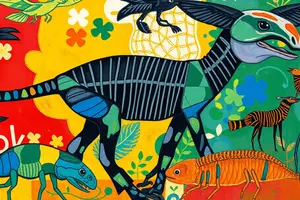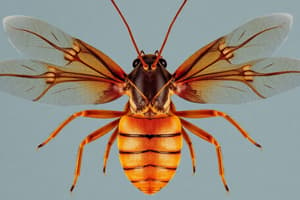Podcast
Questions and Answers
¿Qué característica única de los mamíferos les permite mantener su temperatura corporal internamente?
¿Qué característica única de los mamíferos les permite mantener su temperatura corporal internamente?
Calor endotérmico
¿Qué órgano en los mamíferos se flexiona para permitir la entrada de aire a los pulmones?
¿Qué órgano en los mamíferos se flexiona para permitir la entrada de aire a los pulmones?
Diafragma
¿Qué estructuras en los mamíferos mejoran su capacidad auditiva en comparación con otros vertebrados no mamíferos?
¿Qué estructuras en los mamíferos mejoran su capacidad auditiva en comparación con otros vertebrados no mamíferos?
Tres huesos en el oído medio
¿Qué característica en las hembras de mamíferos les permite alimentar a sus crías?
¿Qué característica en las hembras de mamíferos les permite alimentar a sus crías?
¿Qué órganos en los peces les permiten absorber oxígeno del agua?
¿Qué órganos en los peces les permiten absorber oxígeno del agua?
Menciona una característica única de los peces que les ayuda a vivir en ambientes acuáticos.
Menciona una característica única de los peces que les ayuda a vivir en ambientes acuáticos.
¿Qué estructuras proporcionan estabilidad, equilibrio y propulsión a los peces bajo el agua?
¿Qué estructuras proporcionan estabilidad, equilibrio y propulsión a los peces bajo el agua?
¿Qué característica única de los anfibios les permite evitar la deshidratación?
¿Qué característica única de los anfibios les permite evitar la deshidratación?
¿Cómo se realiza la fertilización en la mayoría de las especies de reptiles?
¿Cómo se realiza la fertilización en la mayoría de las especies de reptiles?
¿Qué característica distintiva de las aves es esencial para el vuelo?
¿Qué característica distintiva de las aves es esencial para el vuelo?
¿Qué órgano en las aves contiene un embrión completamente desarrollado?
¿Qué órgano en las aves contiene un embrión completamente desarrollado?
¿Qué característica común comparten los mamíferos, peces, anfibios, reptiles y aves mencionados?
¿Qué característica común comparten los mamíferos, peces, anfibios, reptiles y aves mencionados?
Flashcards are hidden until you start studying
Study Notes
Vertebrates - A Comprehensive Guide to Various Animal Classifications
Vertebrate animals make up a significant portion of the animal kingdom, with their classification being defined by the presence of a backbone or spinal column. This feature is essential for the support and protection of vital organs within these animals' bodies. In this guide, we will explore some of the major groups of vertebrates, including mammals, fish (or fishes), amphibians, reptiles, and birds (avian species).
Mammalian Animals - Mamíferos
Mammals possess several unique characteristics, such as:
- Warm-bloodedness: They maintain their body temperature internally rather than relying on external environmental factors.
- Diaphragm: Their respiratory system features a large muscle called the diaphragm, which flexes to pull air into the lungs.
- Hair or fur: Most mammals have hair covering their entire body, while other species may have none or minimal hair.
- Three middle ear bones: These structures enhance hearing capabilities compared to non-mammalian vertebrates.
- Nipples: Female mammals produce milk to feed their offspring.
Some famous examples of mammalian species include humans, lions, tigers, bears, and giraffes.
Fish - Pez
Fish are aquatic creatures adapted to life beneath water and have several distinct traits, such as:
- Gills: They absorb oxygen from water through specialized tissue called gills.
- Scales: Many fish species have protective layers of scales that help reduce friction during movement.
- Fins: Fin structures provide stability, balance, and propulsion underwater.
- External fertilization: Most fish species release their eggs into open water, where they develop externally before becoming fully grown.
Notable fish species include clownfish, anglerfish, and dolphinfish.
Amphibians - Anfibios
Amphibians exhibit unique features like:
- Aquatic larvae: Amphibian embryos develop outside the mother's body in water, producing aquatic larvae.
- Moist skin: These animals require moist environments to avoid drying out due to the absence of scales or feathers.
- Lung-assisted breathing: As semi-aquatic organisms, most amphibians have lungs to partially support gas exchange.
- Metamorphosis: Amphibians undergo metamorphosis, transforming from water-breathing larvae into terrestrial adults.
Examples of well-known amphibians include frogs, salamanders, and newts.
Reptiles - Récuidos
Reptiles share common characteristics such as:
- External fertilization: Almost all reptile species lay eggs directly onto the ground without any additional structure around them.
- Dry skin: Scutes or plates cover their skin, preventing dehydration and protecting against abrasions.
- Cold blooded: Unlike mammals and birds, reptiles cannot generate heat internally and rely on external sources to regulate body temperatures.
- Limb movements: Some reptiles have limbs that allow for locomotion, while others, like snakes, have highly flexible bodies.
Popular reptile species include alligators, crocodiles, lizards, and snakes.
Birds - Aves
Birds possess several distinct traits, such as:
- Feathers: These structures provide insulation, protection, and aid in flight.
- Warm blooded: Birds maintain their body temperature internally, which is essential for flight.
- Fused bones: Many bird species have lightweight, fused bones for optimal flight efficiency.
- Internal fertilization: Bird eggs contain a fully-developed embryo, which hatches into a live chick.
Famous avian species include eagles, parrots, penguins, and ostriches.
In summary, vertebrates encompass a wide range of fascinating and diverse animal species, including mammals, fish, amphibians, reptiles, and birds. Understanding the unique characteristics of these groups provides insight into their evolution, ecological roles, and adaptations to their environments.
Studying That Suits You
Use AI to generate personalized quizzes and flashcards to suit your learning preferences.




